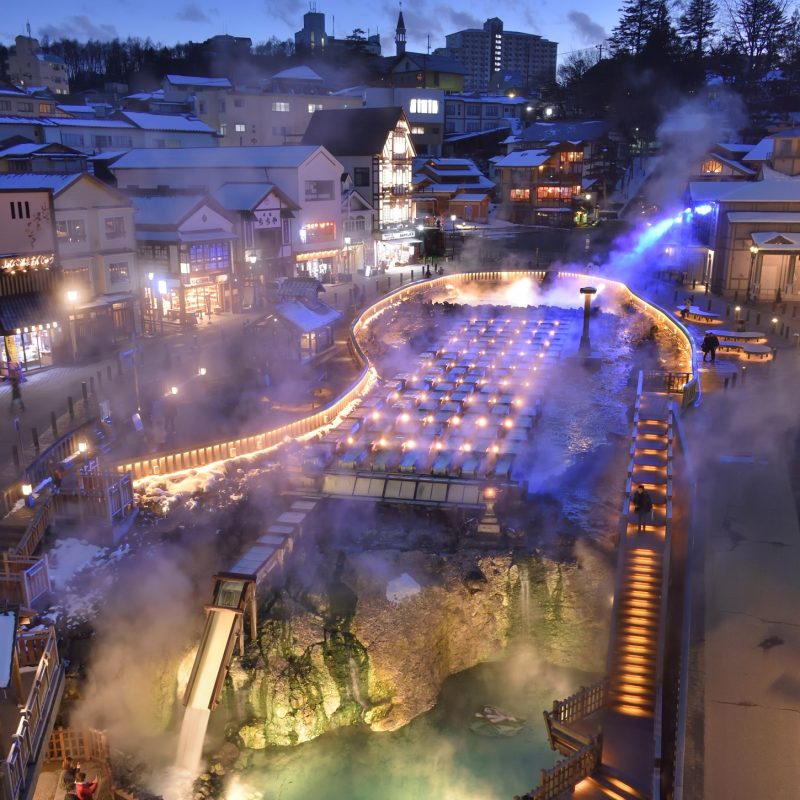YOU CAN ENJOY THE TOP REAL HOT SPRING IN JAPAN, AFTER PLAYING WITH TOURISM.
CONTENTS
Trail
Tenguyama Slope
Family Slope
Onariyama Slope
Aobayama Dai-ichi Slope
Aobayama Dai-ni Slope
Tenguyama Kids’ Park
Shakunage Trail
Kamoshika Trail
R292 Trail
Natsumichi Trail
Natsumichi Challenge Trail
Koridani Snowshoeing Trail & Yazawagawa Snowshoeing Trail
Fun for the Whole Family
Food and Drink
Relaxing Onsen Hot Spring
Tenguyama Play Zone
Tenguyama Tenbo Lift
Koridani Hiking Trail
Yubatake & Saino-Kawara Garden Lights
Yumomi
Snow Wall/Shiga Kusatsu Kogen Route
Recharge at Kusatsu Onsen!
Gozanoyu
Otakinoyu
Sainokawara Rotenburo
Into Enchanted Waters Beloved Since Antiquity
Immerse Yourself in Centuries-Old Bathing Tradition
Enjoying Your Visit !
Just a five-minute drive from the hot spring town of Kusatsu Onsen, this ski resort’s powder snow and fun family activities have attracted visitors since 1935.
With ample amounts of powdery snow, and gentle winter temperatures, Kusatsu is the ideal location for a ski resort. In fact, Kusatsu was one of the pioneers in introducing skiing to Japan. Just two years after skiing was brought to Japan by Austro-Hungarian soldier Major Theodor Edler von Lerch (1869–1945) in 1911, the sport crossed the mountains from Niigata Prefecture to Kusatsu, where it quickly took off. In 1914, just one year after the first skiers took to the area’s slopes, the town’s first ski resort opened. That same year, Kusatsu’s skiing club-the second one in Japan at the time-was established.
In 1935, Kusatsu Onsen Ski Resort—then called Rinkan Ski Resort and consisting of the Tenguyama Slope that still exists to this day—opened its pistes to the public. Since then, it has been home to a number of “firsts” in the development of skiing in Japan. Kusatsu was the first ski resort in Japan to open a chair lift in 1948 and also first resort to operate a ski school. It even hosted Japan’s first ever ski tournament.
Along the way, Kusatsu Onsen Ski Resort has continued to add to its historic lineup, opening new trails, chairlifts, and activities. The latest addition is the R292 Trail, which was opened during the 2018–2019 season.
Skiing the hills of Kusatsu makes you part of the history of the sport in Japan. Visitors will carve up the same slopes as some of the first Japanese skiers did over one hundred years ago.
While most famous for its powder and soothing hot water, Kusatsu Onsen Ski Resort is not just a winter destination. During the green season, the resort is a paradise for outdoor enthusiasts. Kusatsu’s natural scenery and the relatively cool summer climate make exploring the hiking routes and seasonal highland scenery a pleasure. Activities like grass skiing, mountain boarding, putter golf, and tennis are also popular.
In spring and summer, the hills are brightened by alpine flowers, while in autumn the mountainside is ablaze with autumn leaves. Breathe in the clean forest air, whether on the slopes and snowshoe trails in winter or hiking the hills during the green season.
The hot spring area of Kusatsu Onsen sits on a plateau 1,200 meters above sea level, with the mountains in the west of the region reaching elevations of more than 2,000 meters. Considered one of the top three hot spring resorts in Japan, the city is famed for its yumomi bathing culture that grew around a rather unusual way of cooling its piping hot water, and for the large volume of water that springs from its grounds—the highest in Japan at approximately 32,300 liters per minute.
For hundreds of years, a steady stream of bathers has made the journey to Kusatsu to soak in the acidic, sulfur-infused onsen. The water’s antibacterial properties are said to cure every ailment outside of a broken heart! The healing waters were even transported cross-country to alleviate the afflictions of shogun samurai lords.
In the words of a local folk song, “Kusatsu yoi toko; Ichido wa oide,” “Come visit Kusatsu once in your life; you are in for a treat.”
Trail
It opened in 1935. In 1948, very first commercial lift was put on a historic ski area in Japan. Changed the name from “Kusatsu International Ski Area” to “Kusatsu Onsen Ski Resort” from the 2018-2019 season. Along with the name change, it was reborn as a ski resort for beginners and intermediate players, mainly Tengu mountain slope, Mt. Azumi mountain slope, Aobayama slopes. It is perfect for family because kids park and nursery are also substantial. From Aobayama of the slope top of 1600 m, you can see “Mt. Fuji” on a nice day.
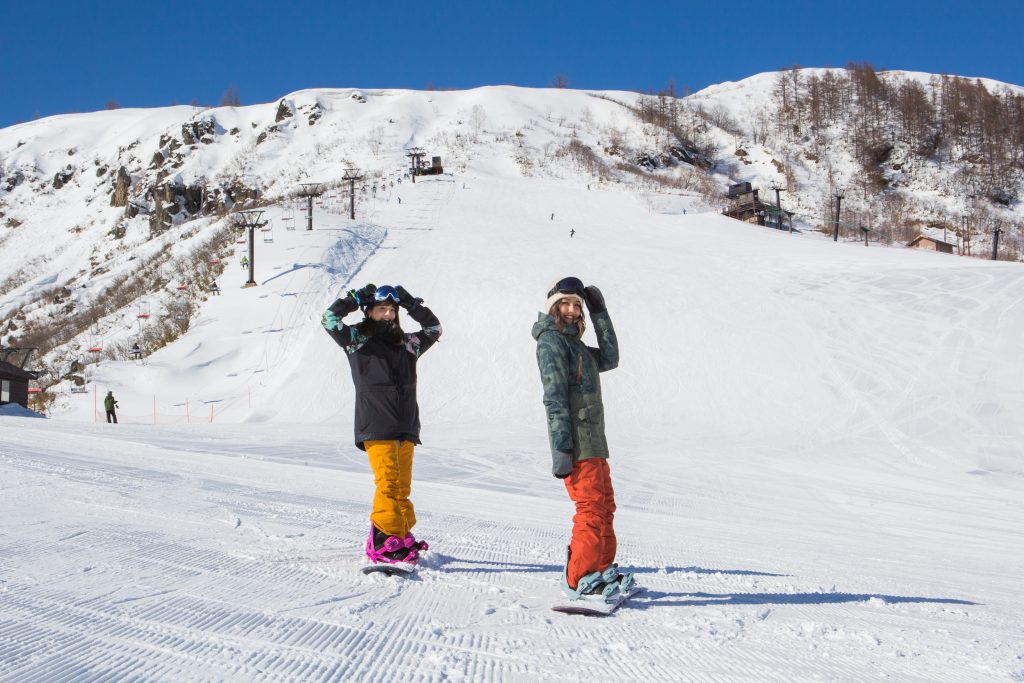
Tenguyama Slope
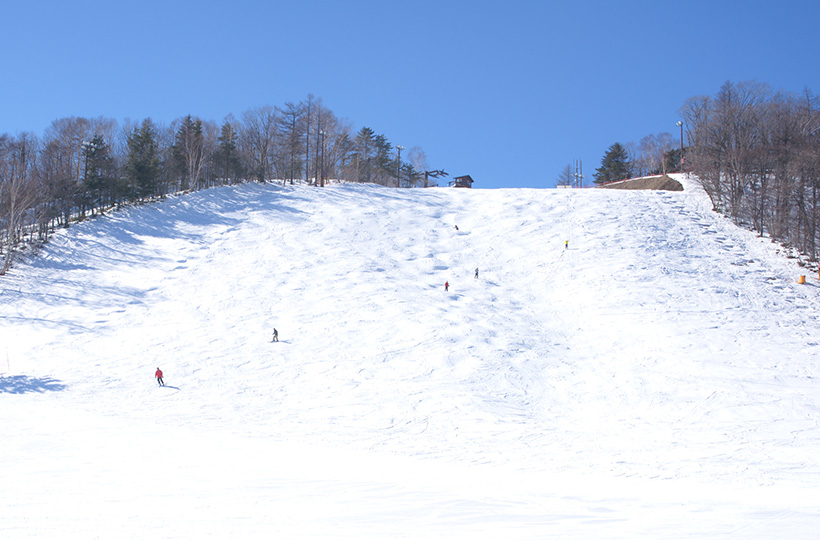
Front and center at Kusatsu Onsen Ski Resort is the Tenguyama Slope, the resort’s main trail. As the resort’s first ski hill-it was opened in 1935-slaloming down Tenguyama allows you to connect with the history of skiing in Japan.
While it is a historic slope, it also offers plenty of fun challenges. Though it may look tame from the bottom, the slope’s upper Tengu no Kabe section is surprisingly steep. While this portion is best left to advanced skiers ready to tackle the 30-degree plunge, less experienced skiers can still enjoy the gentler bottom section of Tenguyama. Joined via other runs, this part of the piste is perfect for intermediate skiers as well as beginners.
On Saturdays and several other days throughout the season, the Tenguyama course is open late with a night-skiing pass for those who just can’t get enough powder during daylight hours.
◆Level: Easy, intermediate, and advanced
◆Course length: 450 meters
◆Average slope degree: 16 degrees
◆Maximum slope degree: 30 degrees
Family Slope
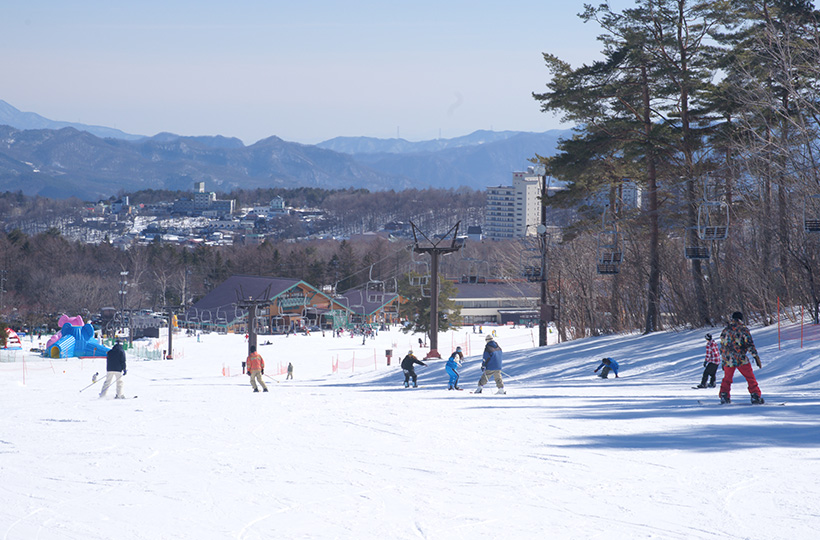
If you are new to the sport, very young, or just a bit nervous, then this is the piste for you. The Family Slope’s gentle hill is safely removed from steeper, faster trails, so beginners can enjoy the descent without worrying about speedier skiers cutting ahead. Just long enough to feel accomplished without getting overwhelmed, this is an excellent option to introduce children to the joys of winter sports.
The Tenguyama Family pair chairlift is also beginner-friendly, as riders can hold their skis or snowboard on the way up, avoiding the tricky process of dismounting from the lift while wearing all your gear.
◆Level: Easy
◆Course length: 450 meters
◆Average slope degree: 8 degrees
◆Maximum slope degree: 8 degrees
Onariyama Slope
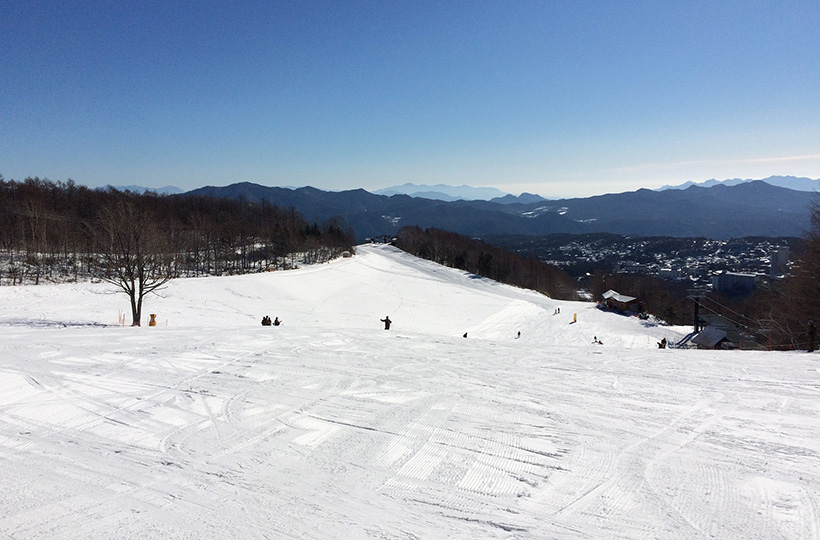
The perfect in-between piste for those ready to progress beyond beginner trails, the Onariyama Slope offers both easy and intermediate skiing across its breadth. The gentle incline with slightly steeper sections provides a chance for confident beginners to take on a challenge without completely leaving their comfort zone, while remaining interesting for more experienced skiers. Combined with the Natsumichi Trail—another intermediate hill suitable for confident beginners—and the bottom-half of the Tenguyama Slope, this long run gives beginners who take up the challenge a tremendous feeling of accomplishment and a good workout. The panoramic views of the Kusatsu Onsen Hot Spring District from the top of Onariyama only add to the thrill of the piste.
◆Level: Easy to intermediate
◆Course length: 250 meters
◆Average slope degree: 8 degrees
◆Maximum slope degree: 18 degrees
Aobayama Dai-ichi Slope
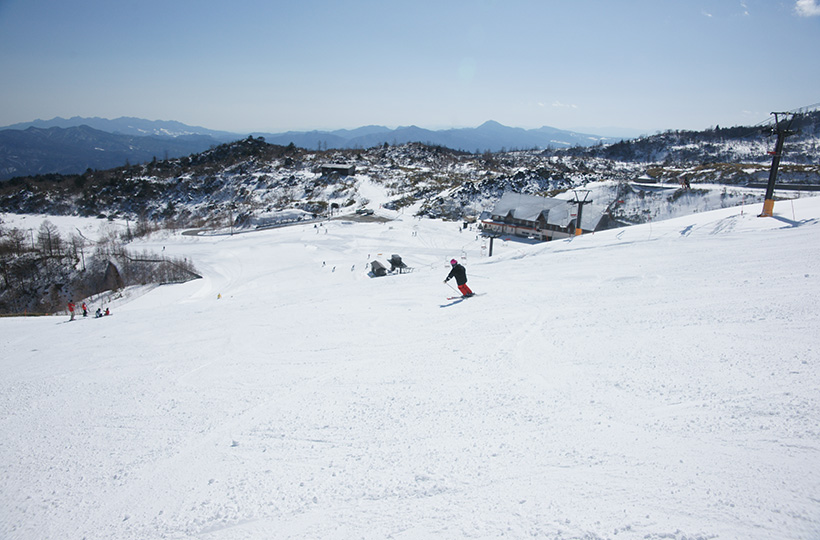
After dismounting from the chairlift have a good look around. On clear days, Mount Fuji is visible in the distance, wishing you luck from 140 kilometers away as you dash down the mountainside—and dash you will, thanks to the run’s maximum 28-degree slope, the second steepest on the mountain. Beginning 1,600 meters above sea level, Aobayama Dai-ichi is the highest slope at Kusatsu Onsen Ski Resort, so breathe deep and slalom into the powdery soft snow.
◆Level: Intermediate to advanced
◆Course Length: 250 meters
◆Average slope degree: 21 degrees
◆Maximum slope degree: 28 degrees
Aobayama Dai-ni Slope
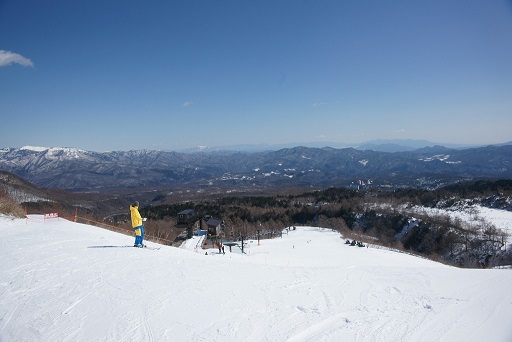
While not as steep as its sister slope Aobayama Dai-ichi, this piste still packs a punch and is recommended for serious skiers up for a challenge. But before you push off, take a minute to savor the scenery spread before you: a panoramic view of the Kusatsu Onsen Hot Spring District. You may even detect the subtle scent of sulfur drifting down from the volcanic peaks, a reminder of the soothing hot springs that await below.
◆しかLevel: Intermediate to advanced
◆Course length: 360 meters
◆Average slope degree: 15 degrees
◆Maximum slope degree: 23 degrees
Tenguyama Kids’ Park
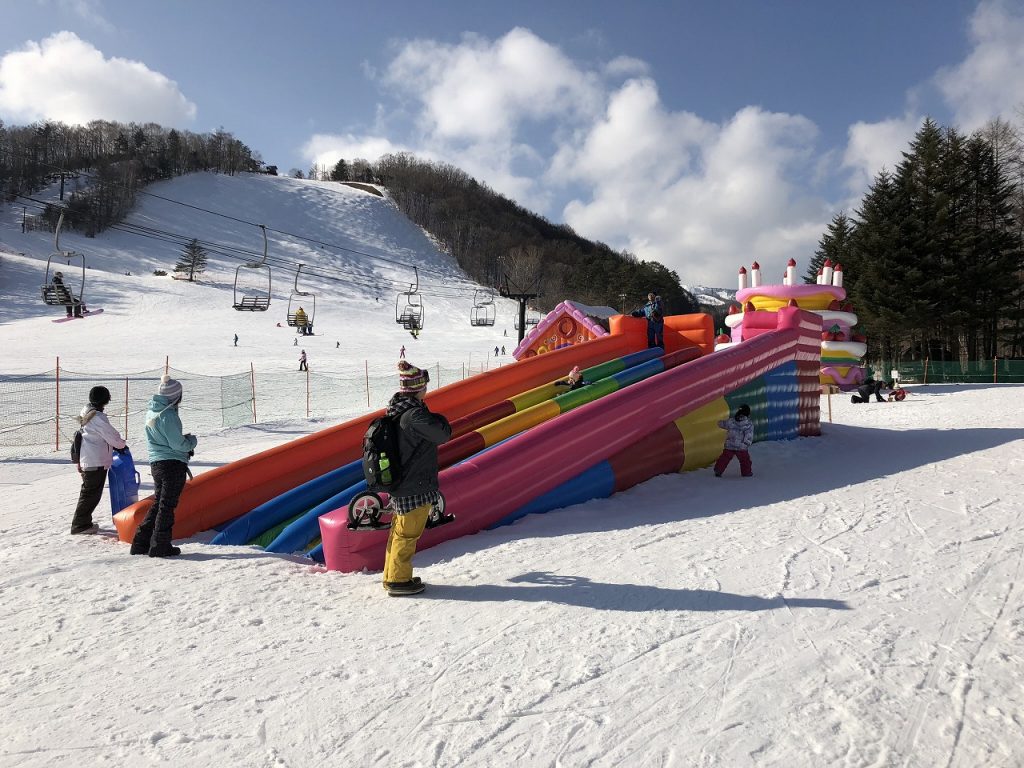
Fun for the whole family, this snow park is a place where three generations (or more) can relax together. Make lifelong memories playing with your young children as they enjoy frolicking in the snow.
A kid-friendly area offering sledding, skiing, and play equipment, the Kids’ Park is a popular option for families with young children. A kids-only nursery slope gives youngsters a chance to safely learn the ropes—without the need for Mom and Dad to worry. Complimentary sledding equipment provides hours of fun for the whole family. To save precious energy best devoted to romping in the snow, the park has a moving sidewalk, allowing kids and partners-in-play to sail down the slope time and time again without having to tow sleds back up the hill.
A bouncy castle and other play equipment add to the excitement, and a covered rest area provides a spot to warm up and take a quick break.
Shakunage Trail
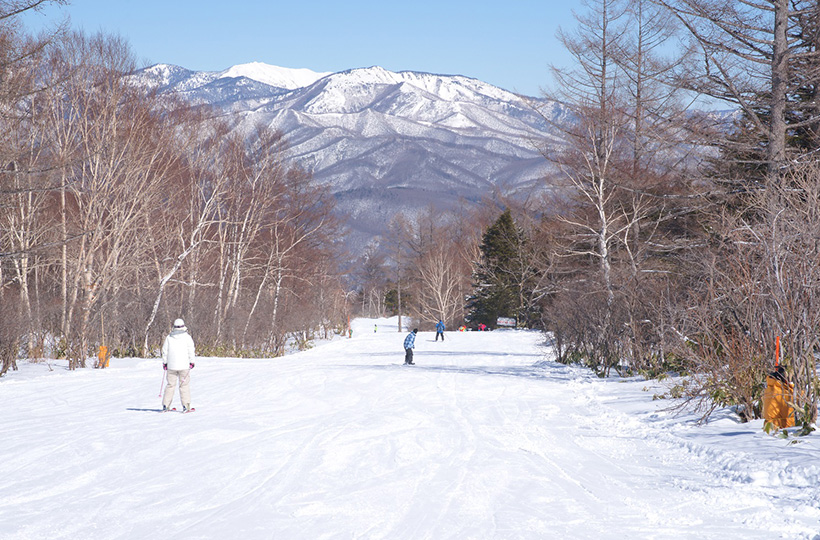
While covered in snow during the winter, this course’s name is firmly planted in spring. The Shakunage Trail is named for the rhododendron, a spring flower beloved by the Japanese, varieties of which can be found throughout Japan. The brightly colored blossoms grow in profusion in alpine areas, and Kusatsu is no exception.
The larch-bordered Shakunage Trail holds the title of “Most Popular Trail with Families” at Kusatsu Onsen Ski Resort. The gentle slope is wide and 3,200 meters long, making it easy enough for beginners while still interesting enough for more advanced skiers. A final run on this scenic route is a great way to end a day on the slopes.
◆Level: Easy
◆Course length: 3,200 meters
◆Average slope degree: 8 degrees
◆Maximum slope degree: 12 degrees
Kamoshika Trail
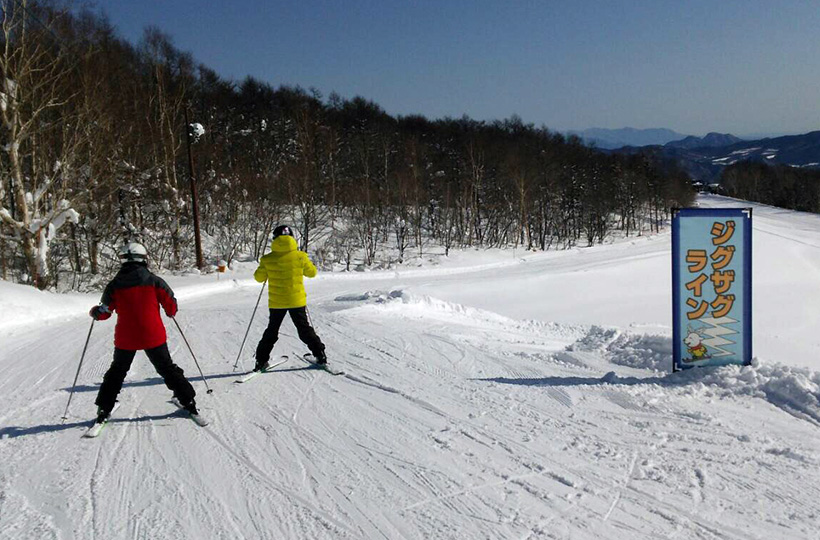
Another run for families keen to ski together, the Kamoshika Trail is a moderate run with slow curves and a few bumps to keep things interesting. Appropriate for beginners looking to try something a little more challenging, Kamoshika provides just the right amount of trial while avoiding tribulation.
Adding to the excitement is the possibility of catching a glimpse of a kamoshika, from which the trail takes its name. Known as Japanese serow in English—and sometimes referred to as a goat antelope—the kamoshika is a protected species that you can find only in Japan. These curious-looking creatures live in the woods that border the run. The chance of catching a glimpse of one of these critters will have kids begging to hit the Kamoshika Trail again and again.
◆Level: Easy
◆Course length: 1,600 meters
◆Average slope degree: 6 degrees
◆Maximum slope degree: 8 degrees
R292 Trail
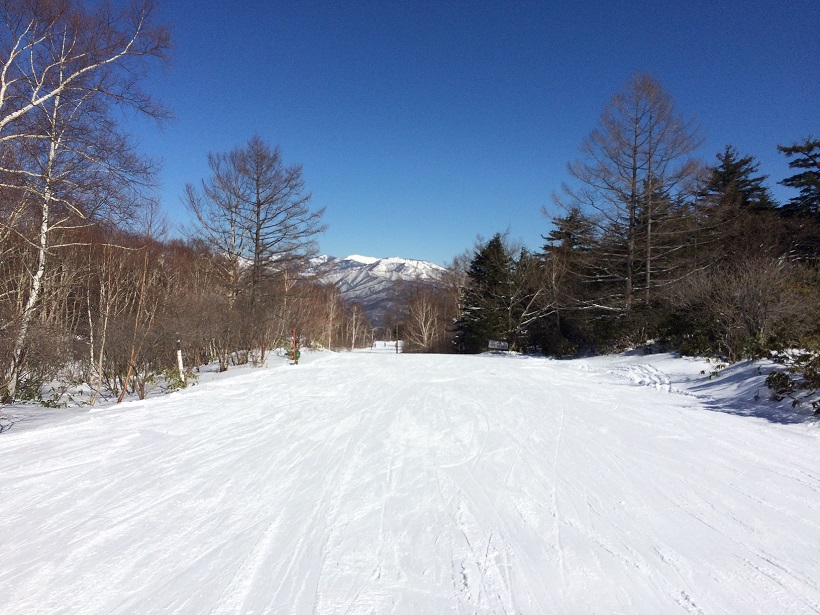
New to the Kusatsu Onsen Ski Resort lineup for the 2018–2019 season, during warmer months the R292 Trail is actually part of National Highway Route 292. Closed to vehicular traffic in winter months due to the region’s substantial snowfalls, the road becomes a slope for skiers and snowboarders of every skill level.
This unusual slope is gentle and wide, so even beginners can pick up some speed gliding down this easy slope as it wends its way partway down the mountain. More confident skiers can extend their run by starting with the Aobayama Dai-ichi slope before joining R292, and then finishing up by cruising down the Tenguyama course by way of Onariyama for an extended run of 4,300 meters.
◆Level: Easy
◆Course length: 2,000 meters
◆Average slope degree: 5 degrees
◆Maximum slope degree: 8 degrees
Natsumichi Trail
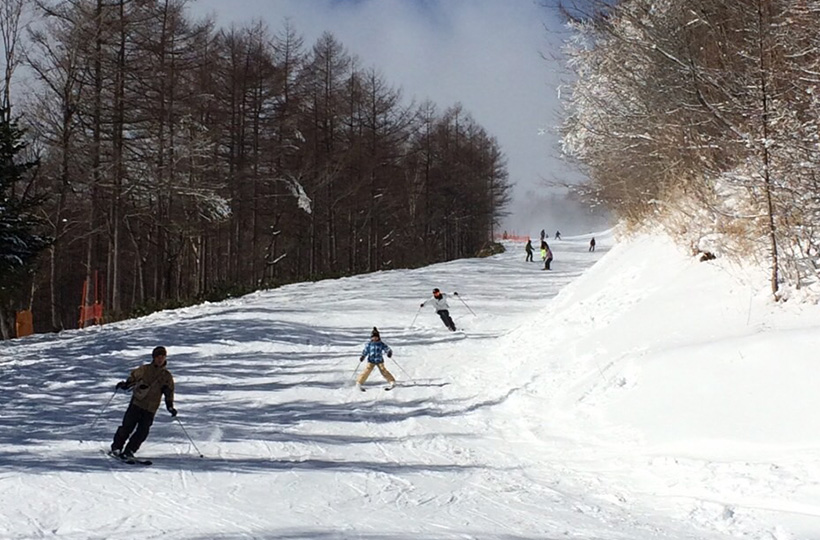
The name of this trail translates as “Summer Road,” which may seem odd for a ski slope. In the days before mass transport, the Natsumichi Trail was an important transportation route that connected Kusatsu to Mount Shirane and beyond. As it was impassable during the winter season, the trail could be used only in snow-free months, leading to its summery name. However, nowadays the mountainside is dedicated solely to the pursuit of outdoor fun.
Curving down the mountain from the top of the Tenguyama lifts, the Natsumichi Trail snakes across the mountainside and under those same lifts to join the main Tenguyama Slope. Adjoining Tenguyama below the advanced-level Tengu no Kabe, this trail is appropriate for beginners and intermediate skiers, making it a good transition course for those ready to graduate from the gentle Family Slope.
◆Level: Intermediate
◆Course length: 600 meters
◆Average slope degree: 10 degrees
◆Maximum slope degree: 15 degrees
Natsumichi Challenge Trail
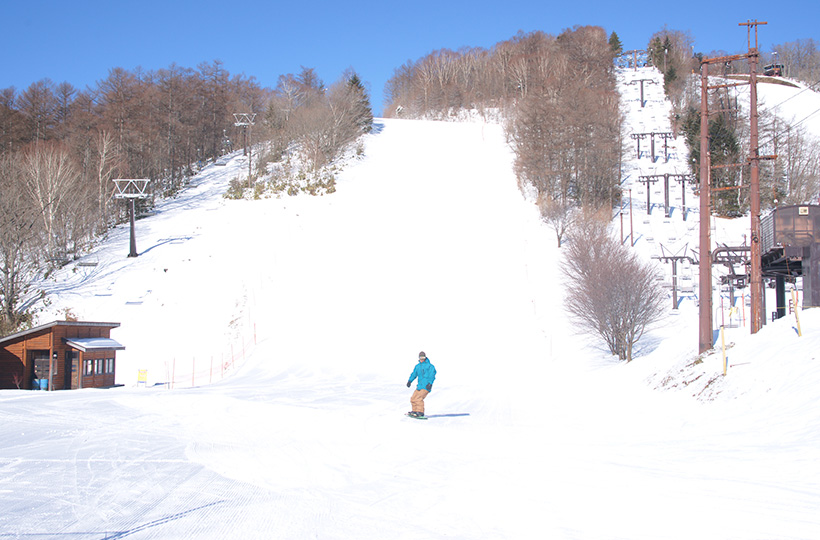
Skipping the final curve of the Natsumichi Trail as it veers towards Tenguyama, and heading straight down the mountain, confident intermediate and advanced skiers can take on the steep piste of the Natsumichi Challenge Trail. This run is not for the faint-hearted, but it will reward skiers with a thrilling ride.
Zipping down the steep mountainside, it is easy to understand why the steep trail was impassable in winter months back when it was just a footpath. With such an impressive gradient, it should come as no surprise to learn that a previous incarnation of the route also included a ski jump.
◆Level: Intermediate to advanced
◆Course length: 300 meters
◆Average slope degree: 20 degrees
◆Maximum slope degree: 23 degrees
Koridani Snowshoeing Trail & Yazawagawa Snowshoeing Trail

Strap on a pair of snowshoes and head into the forest for a winter hiking adventure. Start with a gentle climb among Japanese larch, Mongolian oak, Japanese clethra, Erman’s birch, and Japanese rowan. Keep your eyes peeled for the delicate dried flowers of the deutzia shrub peeking out from under the snow near the trailhead, and the vibrant red berries of the scarlet leaved viburnum near the trail’s end.
Did you know that snowshoeing requires more energy than hiking? You will find plenty of room to flop down in the snow for a rest where the trail widens—why not make yourself comfortable by fashioning a snow table and stools? As you near the double-back point, do not be surprised if you suddenly get a second wind. The Koridani Trail leads to the Koridani himuro or ice room, a spiritual place said to re-energize those who make the pilgrimage.
For the trip back, though it may be tempting to try a different trail, please stick to the Koridani Trail as crossing the ski hills can be dangerous.
◆Length: Two kilometers (round trip)
◆Time: Approximately one and a half to two hours
On the opposite side of the resort from the Koridani Trail, the Yazawagawa Snowshoeing Trail shadows the Yazawa River through the woods. As you make your way through the trees, keep an eye out for rabbit tracks zigzagging across the snow, and pygmy and great spotted woodpeckers poking their heads from cozy cavity nests in old trees.
Look out for the large konara oak near the bend in the river. The claw mark–like scars in the tree’s bark hint of another forest dweller, the bears who roam these woods while no humans are around. But do not worry, they do not venture out in winter.
Keep an eye out for bunches of leaves in the treetops above you as well. These are mistletoe, a plant that grows among the branches of—and receives nourishment from—its host, the Mongolian oak. Further along, natural ice formations decorate the trailside beneath tall Japanese alder and oak, and the delicate dried flowers of the deutzia shrub peek through the snow along the trail’s edges.
A quick note on safety: snow slides are a possibility along the Yazawagawa Trail, so even as you bask in the beauty of the forest, please remain vigilant.
◆Length: Three kilometers (round trip)
◆Time: Approximately two hours
Fun for the Whole Family
Besides skiing and snowboarding down the slopes, Kusatsu Onsen Ski Resort offers many options to enjoy the snow and scenery. With a huge range of winter sports and activities, visitors of all ages and abilities are sure to leave with smiles on their faces. In addition to skiing and snowboarding, Kusatsu Onsen Ski Resort also offers snowshoeing, and for younger children, a sledding hill and an outdoor play park. Indoors, families ready for a break will find a playroom, as well as a supervised day-care center where parents can entrust their young children and enjoy some time alone on the slopes.


Food and Drink
Nothing works up an appetite quite like fresh mountain air, and Kusatsu Onsen Ski Resort has plenty of options to satisfy the keenest skier. Located at the base of the main Tenguyama Slope you will find Tenguyama Main Restaurant, Tengu Cafe, and Tenguyama Lodge. Hungry skiers can choose from a wide variety of Japanese and international dishes, including ramen noodles and katsudon pork cutlet rice bowls, as well as favorites like pizza, beef stew, loco moco, and more. A Special Kids’ Plate, complete with a drink and dessert, is available for younger guests. Be sure to try maitake, a type of mushroom considered a local delicacy!
Skiers craving a snack on the slopes can find high-altitude sustenance at Tenguyama Tenbo Cafe (coffee and light meals), Onari Lodge (hot drinks and snacks), and Aobayama Restaurant (homemade Chinese cuisine).

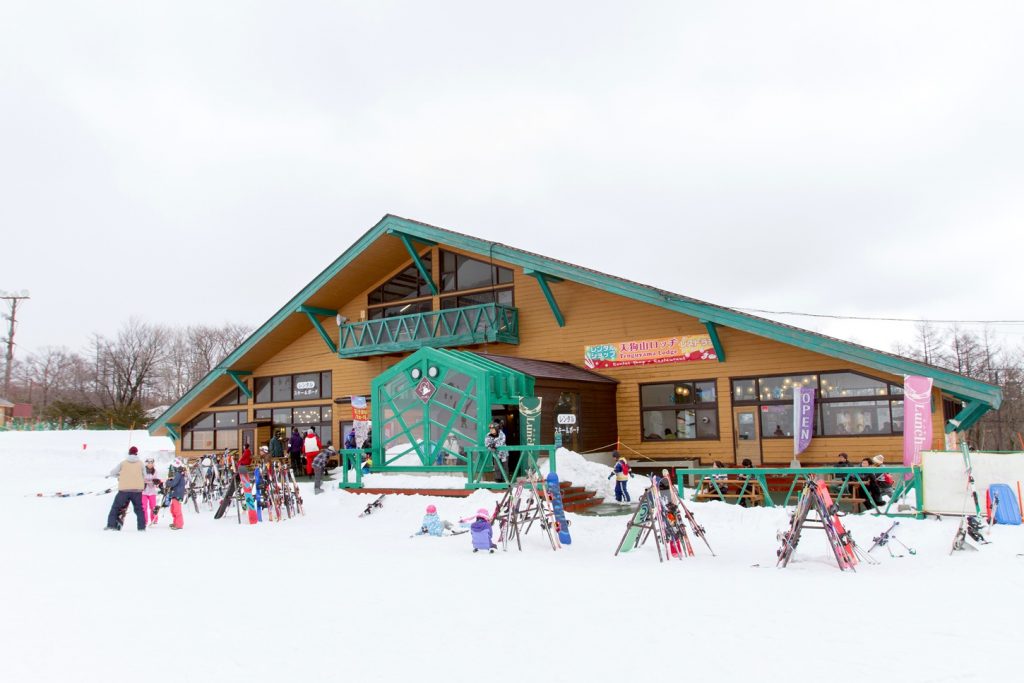
Relaxing Onsen Hot Spring
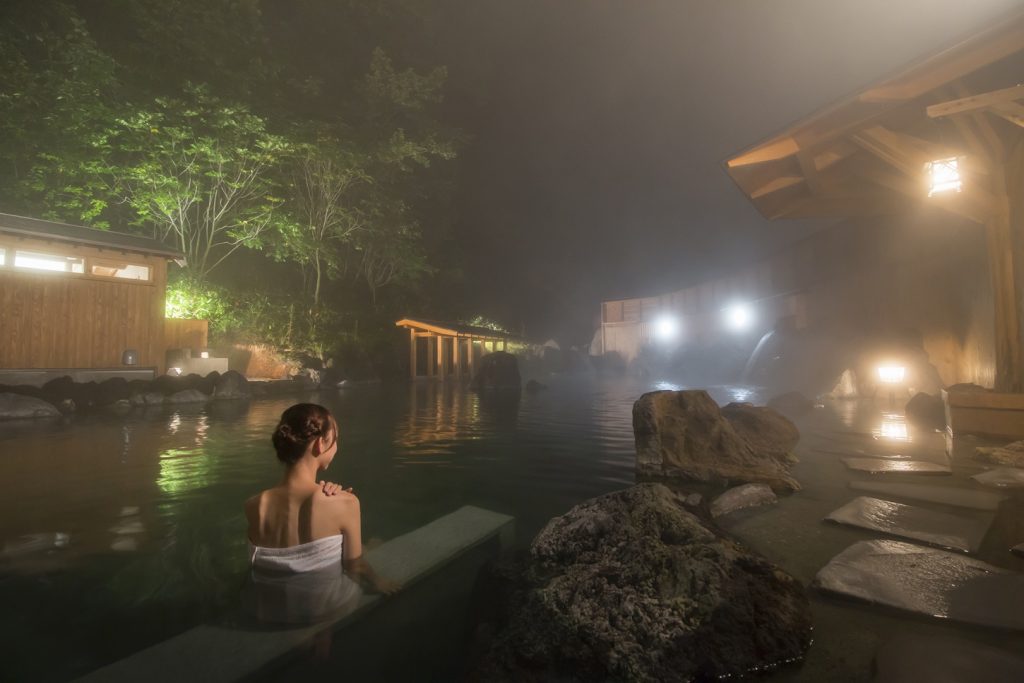
After a day on the slopes, soothe your muscles with a long soak in the local onsen. Kusatsu Onsen is considered one of the top three hot spring regions in the country, and is home to an extraordinary number of public baths and outdoor rotenburo baths, the vast majority of which accommodate international visitors with body art. So do not be shy—ease your tired bones and aching muscles into an onsen and emerge from the restorative waters refreshed and ready to tackle the slopes again.
Tenguyama Play Zone
Far from being a winter-only destination, Kusatsu Onsen Ski Resort offers plenty of green season activities for all visitors—including pets. The verdant mountain scenery and cool, clear air make the region an excellent escape from the heat and humidity of the city.
Visitors as young as three can get their adrenaline pumping as they fly through the air on the resort’s bungee trampoline, where one jump will send you soaring skyward for mid-air somersaults. Feel the need for speed? Rent a mountain cart or mountain board and scoot down the slopes as fast as you dare.
For slower speeds but still top-notch fun, try scooting across the summer slopes on push scooters and stand-up Ninebot scooters. Grass skiing allows those who miss the snowy slopes to slalom down the hills even in high summer.
More relaxing recreations like mini-putt or mallet golf are also available, while the entomologically inclined can rent butterfly nets and bug boxes and spend the day studying local fauna. For furry family members, the dog run will have tails wagging.
Tennis courts are located nearby; and soccer balls, frisbees, badminton sets, and glove sets are available for rent, to be used on the miniature athletic field and free space.
◆Green season: Late April until early November; 9:00 am until 5:00 pm (final entry 4:00 pm)
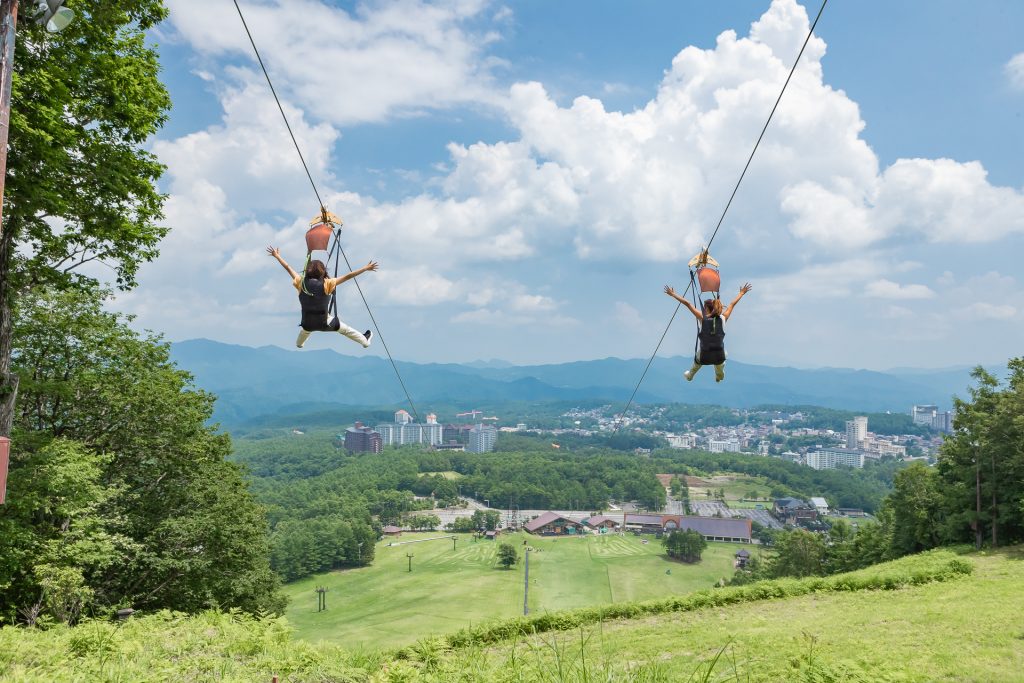
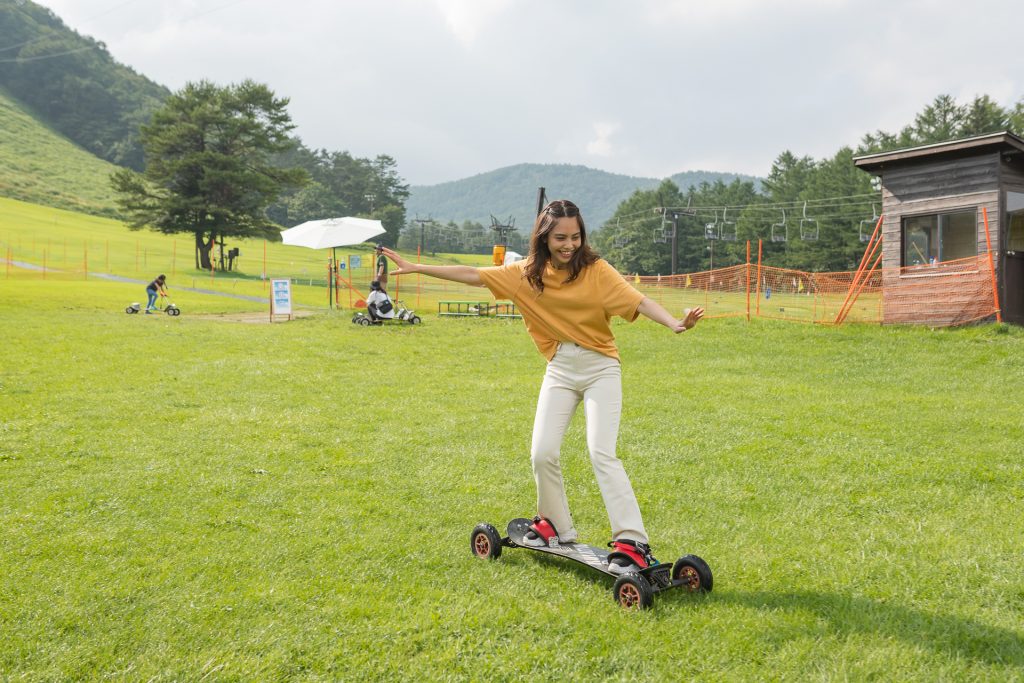
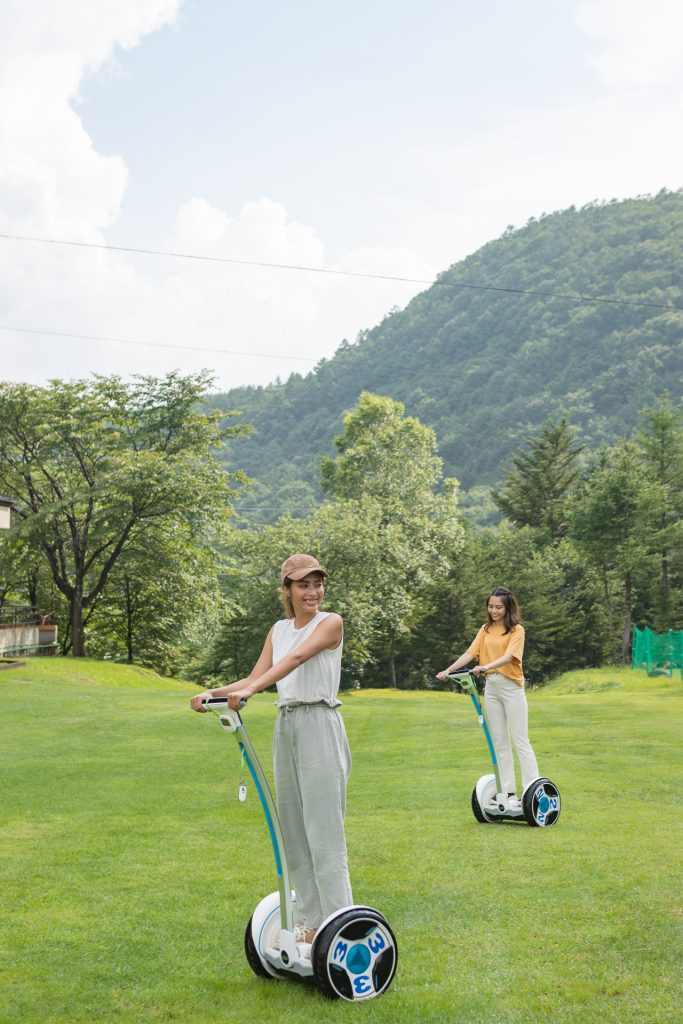
Tenguyama Tenbo Lift
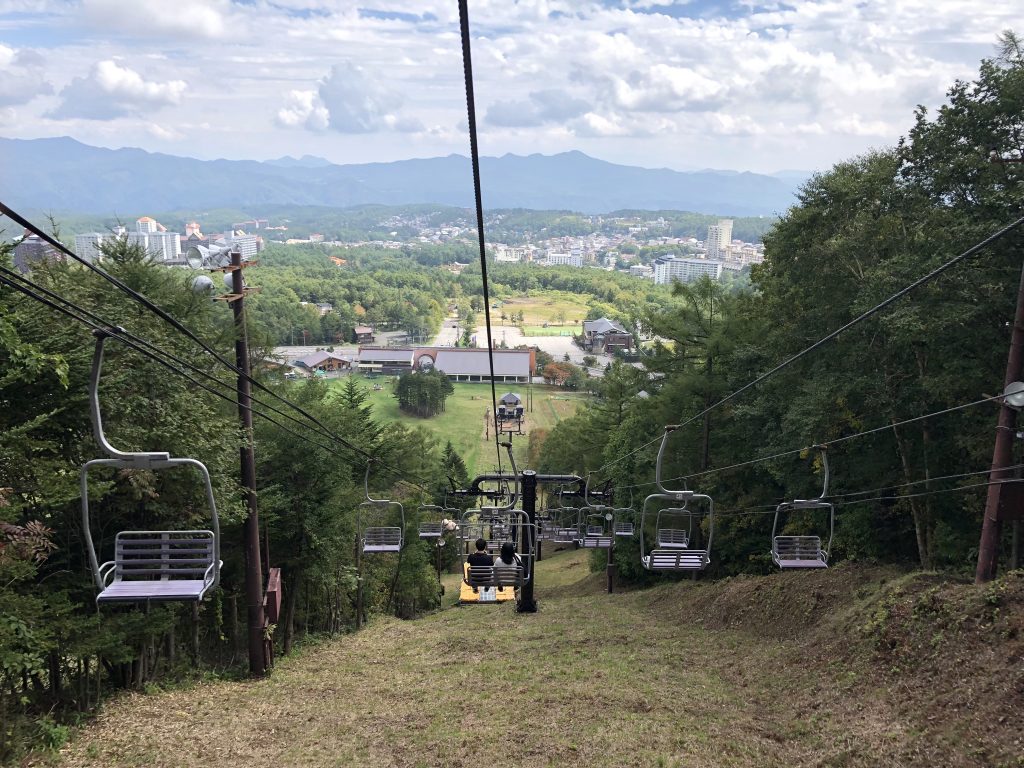
Serious hikers and sightseers alike can hop on the Tenguyama Tenbo Lift and sail up the mountainside while enjoying majestic views of the Kusatsu Onsen area and the beauty of the distant mountains. In autumn, the fiery colors of the forested slopes are particularly photogenic.
As you glide up the mountain in the green season, take a moment to look down at the Tenguyama Slope beneath your feet, and imagine the green grass buried under deep white snow and dotted with skiers carving their way down the hill in winter.
After dismounting from the lift, take your time wandering the mountainside. In spring look for the pink Epigaea asiatica, azaleas, and rhododendrons that bloom in May and June. Stop by the Tenguyama Tenbo Cafe for coffee and a light meal before boarding the lift for the return trip—and one last chance to savor the bird’s-eye view of Kusatsu Onsen and the mountains of Gunma.
◆Tenguyama Tenbo Lift: May until November (Please check for holidays and availability in advance); 9:00 am until 4:00 pm
Koridani Hiking Trail
A hike through the hills does a body—and soul—good, and Kusatsu’s forested trails certainly fit the bill. The three main courses vary in length from three to sixteen kilometers (roundtrip), providing options for casual to serious hikers. Those in need will find trekking poles and other equipment for rent at the base of the hills.
Along the trails you can spot seasonal plants, such as the brightly colored blossoms of rhododendron, azalea, fringed galax, thistle, heath, scarlet leaved viburnum, and the fluffy heads of tussock cottongrass. The forests are dense with trees, moss, and enough flora and fauna to satisfy nature-lovers and photographers alike.
The shortest of the hikes, the Koridani Hiking Trail, begins near the base of Kusatsu Onsen Ski Resort. Starting near Tenguyama Rest House, the route winds beneath the leaves of Japanese clethra, Mongolian oak, and Japanese larch, Erman’s birch, Japanese rowan, and scarlet leaved viburnum as it ascends the mountainside. Along the trail’s edges, here and there luminous moss grows in shadowy corners and rocky caves.
The Koridani Hiking Trail leads to a cave believed to be a spiritual place that endows visitors with healing energy. The cave is called the himuro, or ice room. True to its name, ice remains in the cave until July, keeping the temperature low and refreshing even during the hottest days of summer. Whether you are a believer or not, the himuro and its environs can give you a taste of ancient Japanese spiritual traditions.
The moderate path of the Koridani Hiking Trail is suitable for all levels, though proper footwear—and sound preparations suitable for changeable weather—are advised.
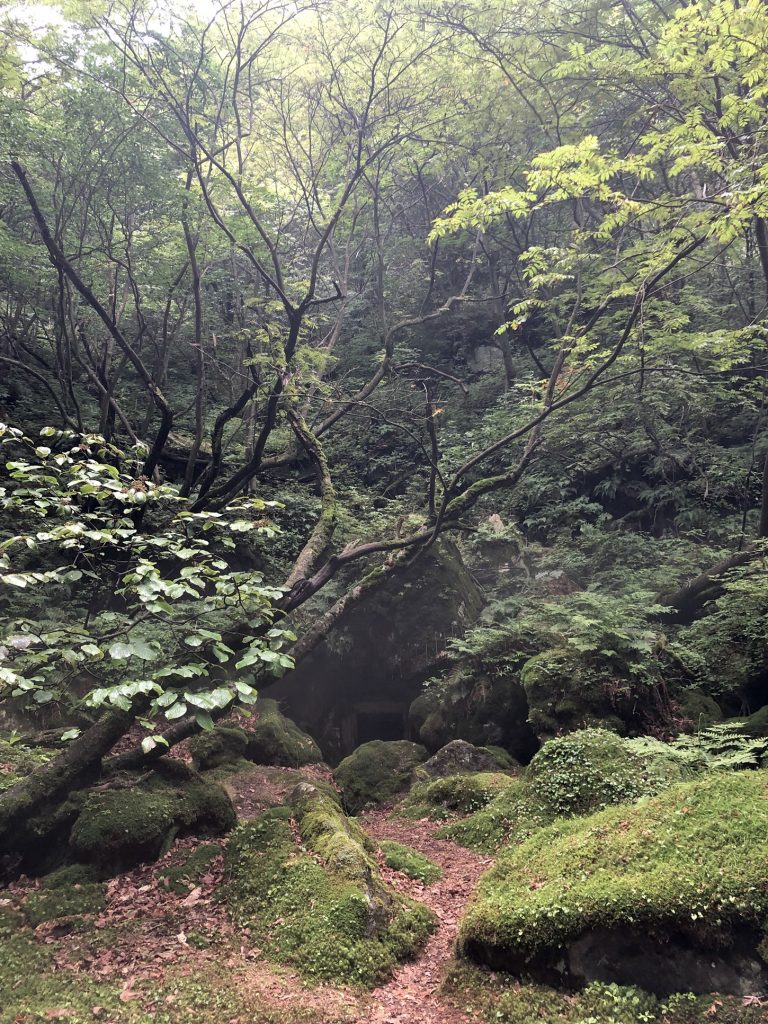
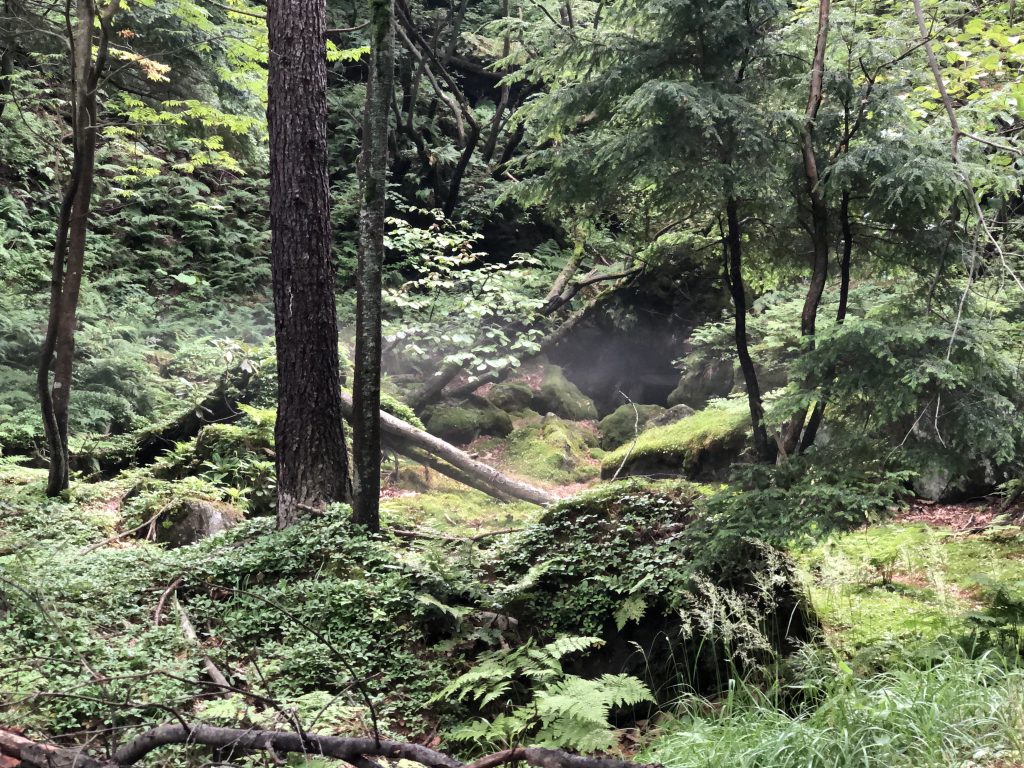
Yubatake & Saino-Kawara Garden Lights
A facility that adjusts the sampling of hot springs and the temperature of hot water by hanging the source of hot springs on the ground surface or wooden gutters. Yubatake located in the center of hot spring town is the symbol of Kusatsu Onsen. A hot spring of 4000 liters per minute is gushing out, and it always boils the hot water. From March 2017, night lights will be installed at Kusatsu Onsen’s “Yubatake” (Hot Water field) and “Saino-Kawara Koen” (Saino-Kawara Park) to create a magical feel during the evening.

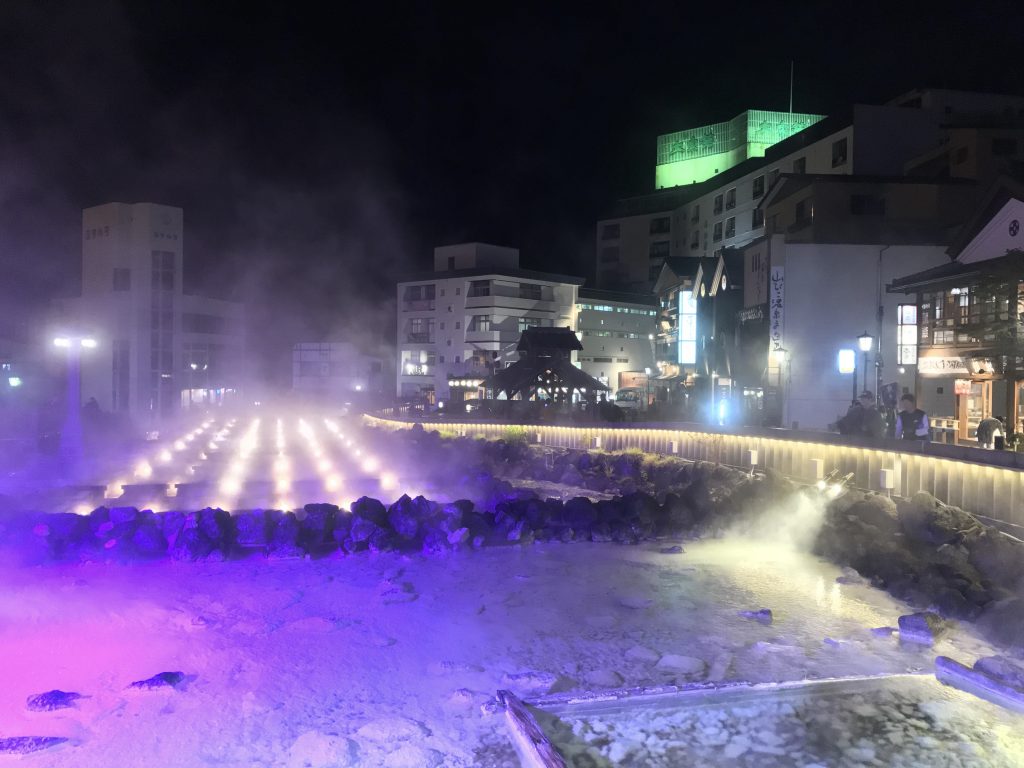
Yumomi
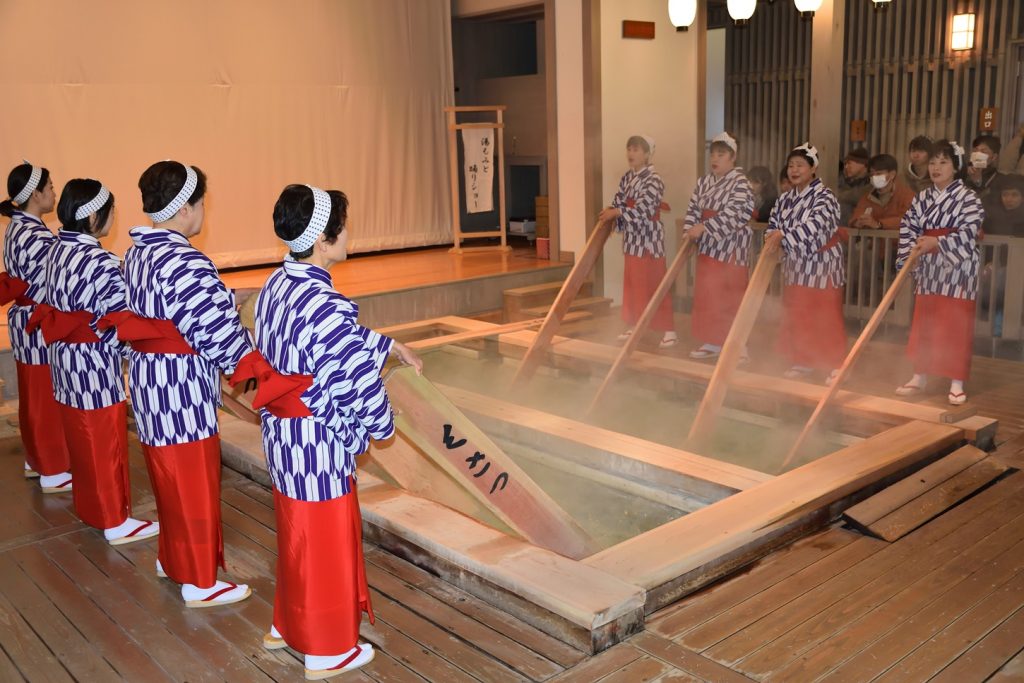
At Kusatsu Onsen there is a bathing method that continues from the Edo era called “Jikanyu”. The spring water is 51 to sometimes 94 degrees centigrade with strong acidic qualities. Because of these conditions it is difficult to get into the baths so a method called “Yumomi” was created to naturally reduce the water temperature without adding water. It is now a Kusatsu tourist attraction with locals making regular demonstrations while singing local folk songs.
Snow Wall/Shiga Kusatsu Kogen Route
The scenery of the snow corridor is the best part of the opening of the Kusatsu Shiga Kogen Route in late April. Driving that goes inside the snowy wall between both sides is unique to mountain roads that passing through high altitude points, and many tourists visit to see it. The snow corridor, which has advanced for 5 to 10 minutes from the Shibutoge Pass on the border of Nagano Prefecture to Gunma Prefecture in the direction of Kusatsu Onsen, is worth seeing. In places with a lot of snow, it is about 8m.
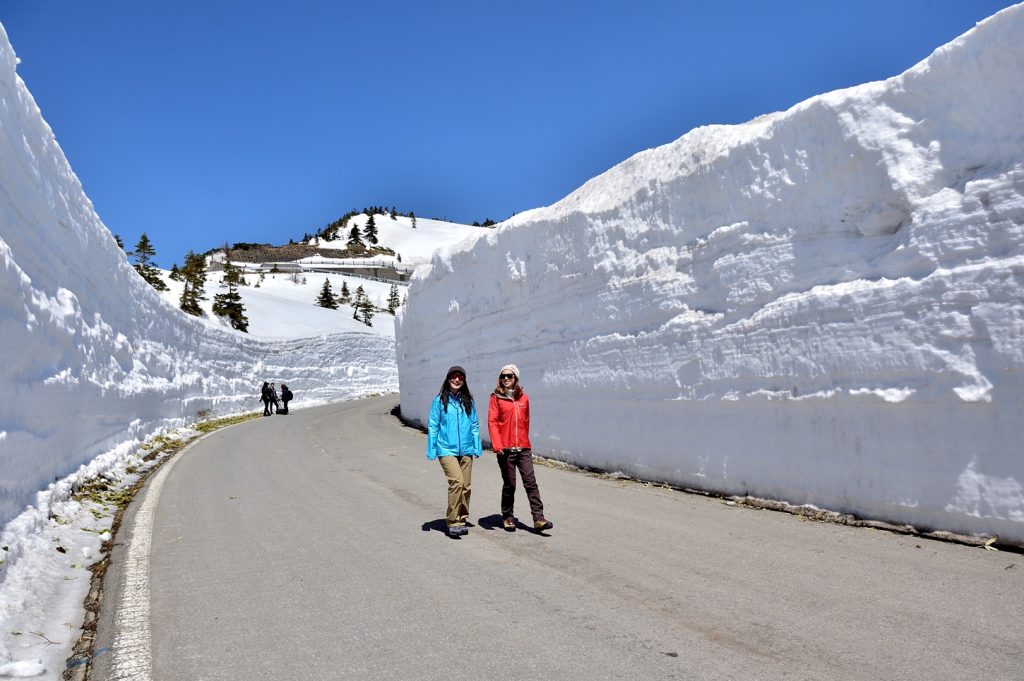
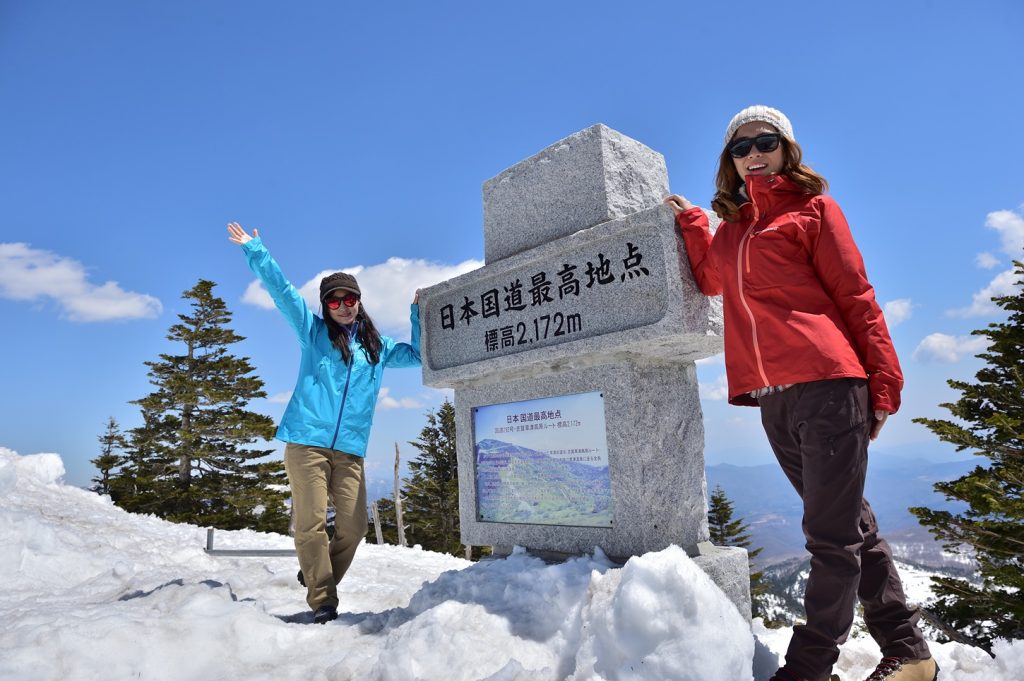
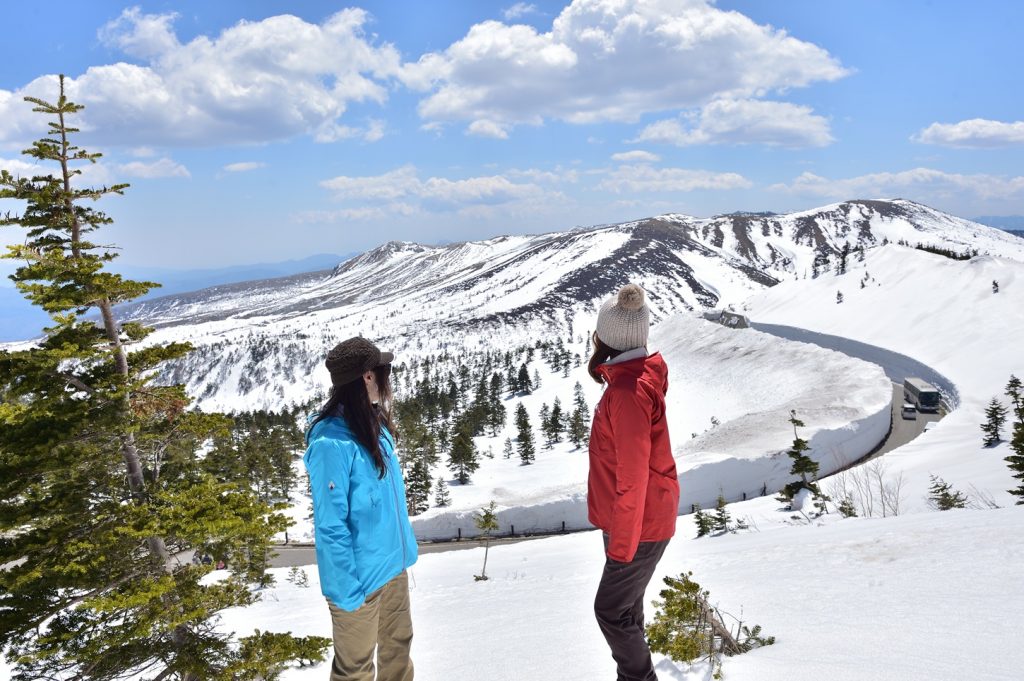
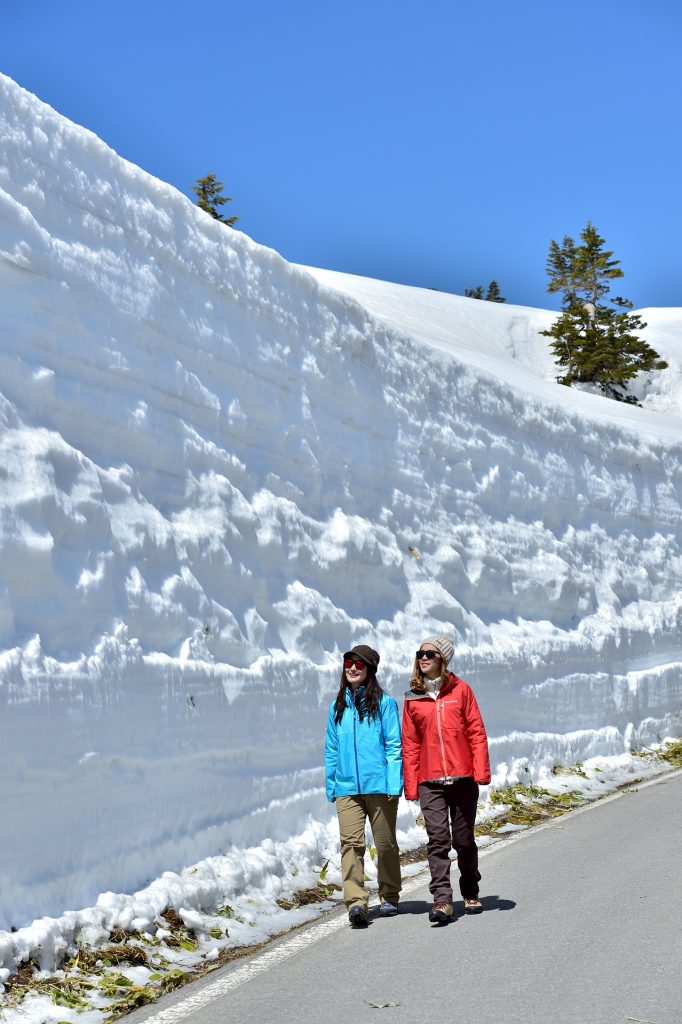
Recharge at Kusatsu Onsen!

Having spent a day in the great outdoors, it is time to relax in one of Kusatsu’s natural hot spring baths, commonly known as onsen.
Bathing has been a major part of Japanese culture since antiquity, and Kusatsu Onsen’s baths are a fantastic chance to dip your toe (and more!) into this essentially Japanese cultural experience. Do not just take our word for it either—Japan’s major travel agents have voted Kusatsu Onsen the number-one onsen in Japan for over fifteen years in a row.
The bountiful waters drawn directly from the Yubatake hot spring fields naturally contain acid, sulfur-containing aluminum sulphate, and chloride, with pH values between 1.7 and 2.1, and temperatures varying between 51 and 94 degrees Celsius. An iron nail placed in the hot spring would be reduced to rust in just nine days. But do not worry, the centuries-old yumomi method of cooling the water makes it perfectly safe for everyone to enjoy, and the accompanying ceremony is now a local attraction, with regular demonstrations enlivened by folk songs.
The rich mineral content of Kusatsu’s waters have become known for their metabolism-boosting effects and as a natural way to promote more beautiful skin. The hot springs are also said to be beneficial for a variety of conditions, including muscle pain, bruises and sprains, fatigue recovery and more. Said to cure basically everything except lovesickness, you are bathing in good company—even the leaders of the Tokugawa shogunate during the Edo period (1603–1867) ordered barrels of hot spring water to be delivered to Edo Castle.
Take a deeper look into three of Kusatsu Onsen’s famed hot spring baths.
Gozanoyu
Located in the center of Kusatsu Onsen overlooking the iconic Yubatake hot spring fields, Gozanoyu has been loved and enjoyed by bathers looking to relax in its natural waters for over 1,000 years.
The main building was re-created in April 2013, using Japanese turn-of-the-century architecture with Japanese cedar wood totonbuki roofs and wall plaster characteristic of the early Meiji period (1868–1912). Back then the whole township would relocate to the warmth of the onsen during the harsh wintertime. Built with traditional techniques and harmonious natural materials, a visit to Gozanoyu is like stepping back in time.
Inside the onsen itself there are two stone and wooden baths, both constantly filled from two springs: the Yubatake spring with acidic sulfur and Bandai spring with acidic chloride sulphate, the latter said to be beneficial for neuralgia, joint pain, and burns among other conditions. Visitors can try both types of hot spring water, as the baths are available for men and women on alternating days.
Also inside the building are two Japanese-style halls for bathers to unwind and rest after soaking in the waters. The great hall is over 100 meters square with good views of the Yubatake hot water fields and is free for all visitors to Gozanoyu to use. The middle hall is available for rent at 2,000 yen per hour, for those who want a more private onsen experience with friends and family.
Be sure not to miss out on Gozanoyu’s exclusive “Yukata de Sanpo” course, where both men and women can dress in a stylish light cotton kimono, for an authentic Japanese onsen adventure. The three-hour experience includes the full set-up with robes, sandals, and a handy bag, with a free dressing service on hand to make sure you look your best. Photo opportunities and a suggested walking course around the Kusatsu area help you to make the most of your visit.
Available all year round, take the opportunity to don traditional Japanese clothing and enjoy the atmosphere of Kusatsu town and Gozanoyu in the time-honored fashion. The course costs 2,500 yen and includes entry to Gozanoyu.
◆Gozanoyu
Opening hours: 7:00 am–9:00 pm (entry closes at 8:30 pm) * may change according to season
Prices: Adults 600 Yen, Children 300 Yen (ages 3–12)
Inquiries: Oazakusatsu 421, Kusatsu Town, Agatsuma County, Gunma Prefecture 377-1711
Tel: 0279-88-9000
http://gozanoyu.com/en/
-988x1024.jpg)
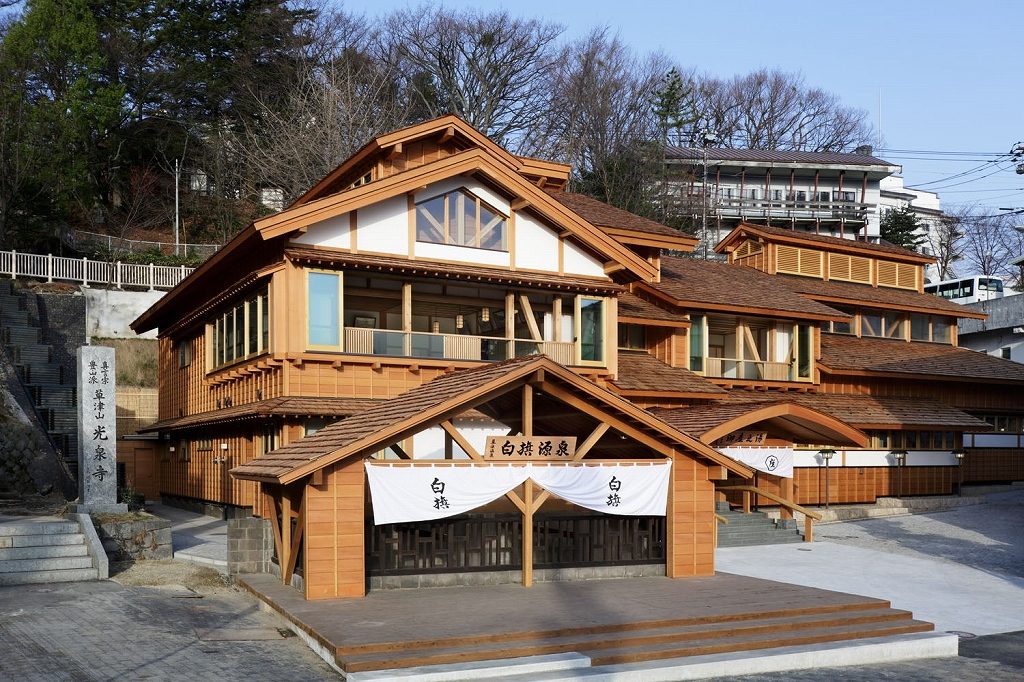

Otakinoyu
Known as the “hot spring of beauty,” Otakinoyu is just minutes from the Yubatake hot water fields of Kusatsu.
Drawing its water from the Nikawa hot spring source with acidic sulfur, Otakinoyu’s 100% natural free-flowing water baths have long been beloved by Japanese men and women alike. The awase-yu baths with gradually escalating temperatures have been popular since ancient times and may be the secret to clear and healthy skin.
These spa waters are said to be beneficial for skin complaints and disorders as well as general skin beautification, making Otakinoyu an ideal spot to indulge in a little self-care. The onsen has special “cloudy water” days on the second and fourth Saturday of each month when the hot spring deposits are cleaned from the piping mechanisms, resulting in spring water densely filled with enriching minerals.
Otakinoyu offers various baths partitioned for men and women, with its famed awase-yu baths varying in temperature from a relatively cool 38 to a steamy 46 degrees Celsius. These temperatures are maintained not by dilution but by natural cooling, which allows bathers to become accustomed to the naturally high temperature and acidity of the hot spring waters. The awase-yu bathing style has been a huge draw for Japanese travelers for centuries and is quite rare even in Japan, so be sure to experience it for yourself.
Other baths include the vast great bath and open-air bath, both partitioned for men and women, as well as hot water cascades that mimic the natural flow of waterfalls.
Otakinoyu also offers private “Shakunage” baths for rent at 2,000 yen per hour, available for couples and families to bathe together, and these private baths are barrier-free for all to enjoy.
Otakinoyu doesn’t just offer bathing but a full resort experience, as visitors to the onsen are also able to relax in the lounge café with premium Japanese-style ice cream, try Kumazasa udon at the Yunohana restaurant, or find that perfect gift at the souvenir shop.
Other facilities include a sauna and massage rooms, as well as relaxation rooms for families and private functions available from 1,000–2,000 yen per hour.
With such a wide range of bathing, cuisine, and relaxation options on offer, Otakinoyu is a luxurious Japanese onsen experience that is sure to be the highlight of your journey to Kusatsu Onsen.
◆Otakinoyu
Opening hours: 9:00 am–9:00 pm (entry closes 8:00 pm)
Prices: Adults 900 Yen, children 400 Yen (ages 3–12); towel sets are available for 250 Yen
Inquiries: Oazakusatsu 596-13, Kusatsu Town, Agatsuma County, Gunma Prefecture 377-1711
Tel: 0279-88-2600
http://ohtakinoyu.com/en/
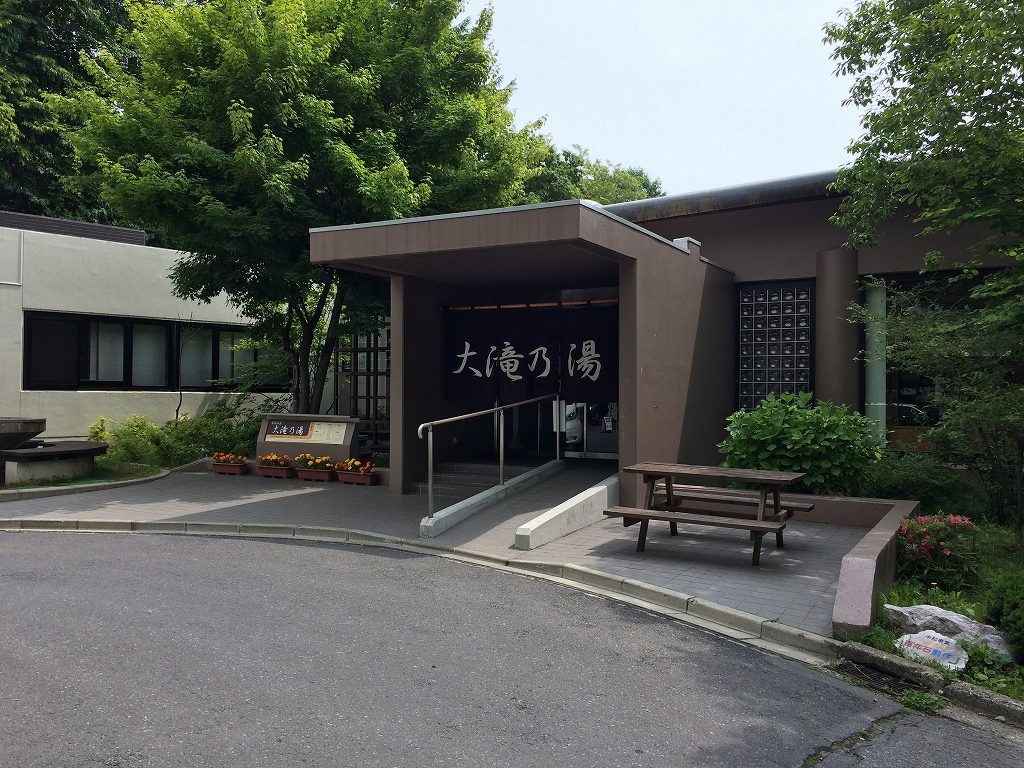
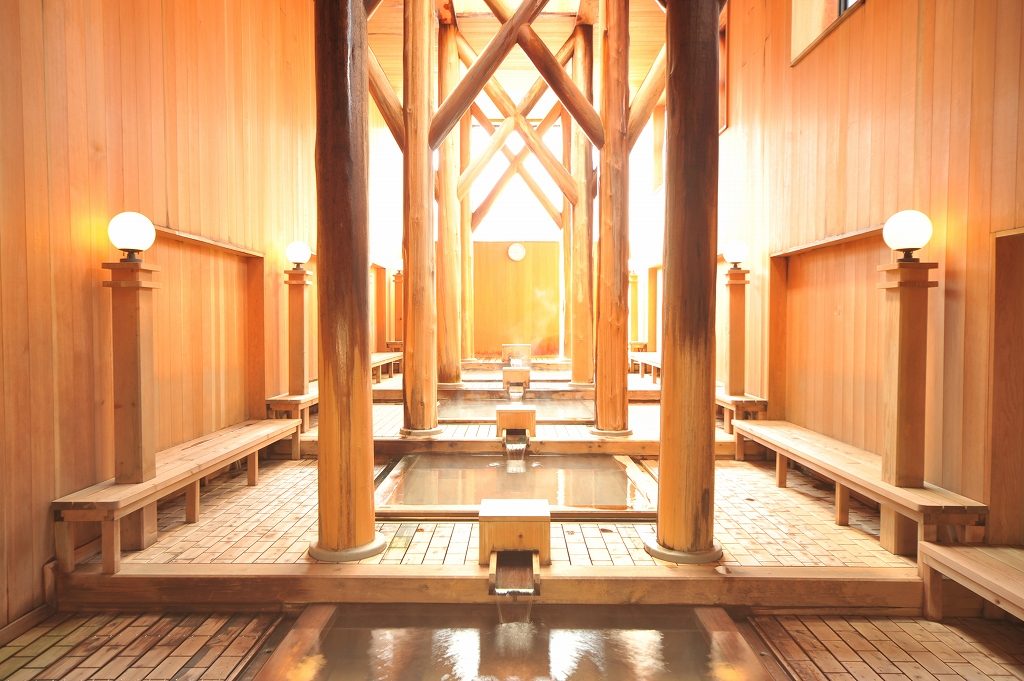
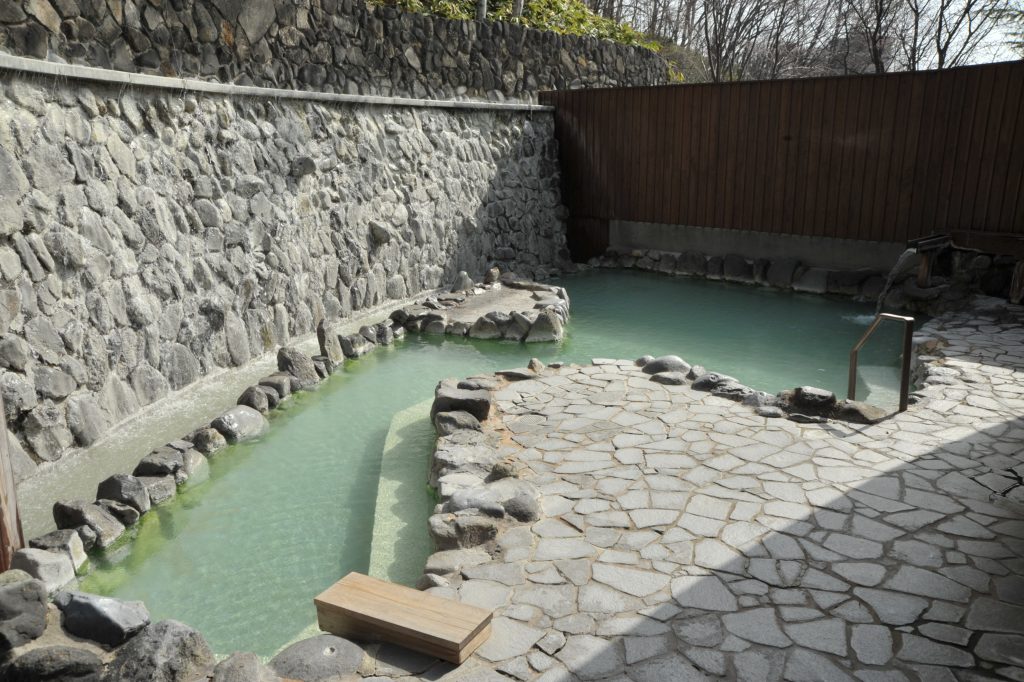
Sainokawara Rotenburo
A short twelve-minute stroll from the Yubatake hot water fields in the center of Kusatsu town brings you to Sainokawara Rotenburo, for a truly natural outdoor onsen experience.
The large outdoor bath (rotenburo) is separated for men and women, and at 500 meters square can comfortably accommodate up to one hundred people at a time, making this a good choice for larger groups. Fed by the Bandai hot water springs containing acidic chloride sulphate, and recommended for conditions including chronic digestive diseases and recovery from illness, the vast bath also features a hot waterfall-like cascade.
Sainokawara Rotenburo can be enjoyed at any time of year, and the four seasons provide a rotating backdrop to the baths. On clear nights, you can enjoy stargazing, while the changing autumn leaves bring a touch of vibrant colors to the experience. In winter, soaking in the hot waters of the bath under a gentle snowfall is unforgettable.
Although located just a short walk from Kusatsu Onsen town center, Sainokawara Rotenburo is very much part of the countryside of the area. A stone-paved promenade leads visitors along a winding path past a variety of popular sightseeing spots including Anamori Inari shrine, the Oni no Chagama monument, Matchmaking Jizo (a series of Buddhist statues which are said to be protectors of children and travelers), and the Kusatsu Visitor Center. This easy path is a good introduction to the natural beauty of the surrounding area. Not only can you immerse yourself in the healing waters of the outdoor bath but also in the history and culture of Kusatsu.
On your walk, be sure to seek out the busts of German physicians Dr Erwin Bälz and Dr Julius Scriba, local heroes of Kusatsu Onsen who were instrumental in expounding the healing virtues of the hot springs in Japan and abroad.
Sainokawara Rotenburo also offers an evening of mixed bathing every Friday, when the bath is open to everyone, including couples and families. During the mixed bathing evenings visitors can wear swimwear or wrap themselves in a towel, a chance to enjoy the full onsen experience together.
◆Sainokawara Rotenburo
Opening hours: April 1st–November 30th 7:00 am–8:00 pm (entry closes at 7:30 pm), Dec 1st–March 31st 9:00 am–8:00 pm (entry closes at 7:30 pm)
Prices: Adults 600 Yen, children 300 Yen (ages 3–12)
Inquiries: Oazakusatsu 521-3, Kusatsu Town, Agatsuma County, Gunma Prefecture 377-1711
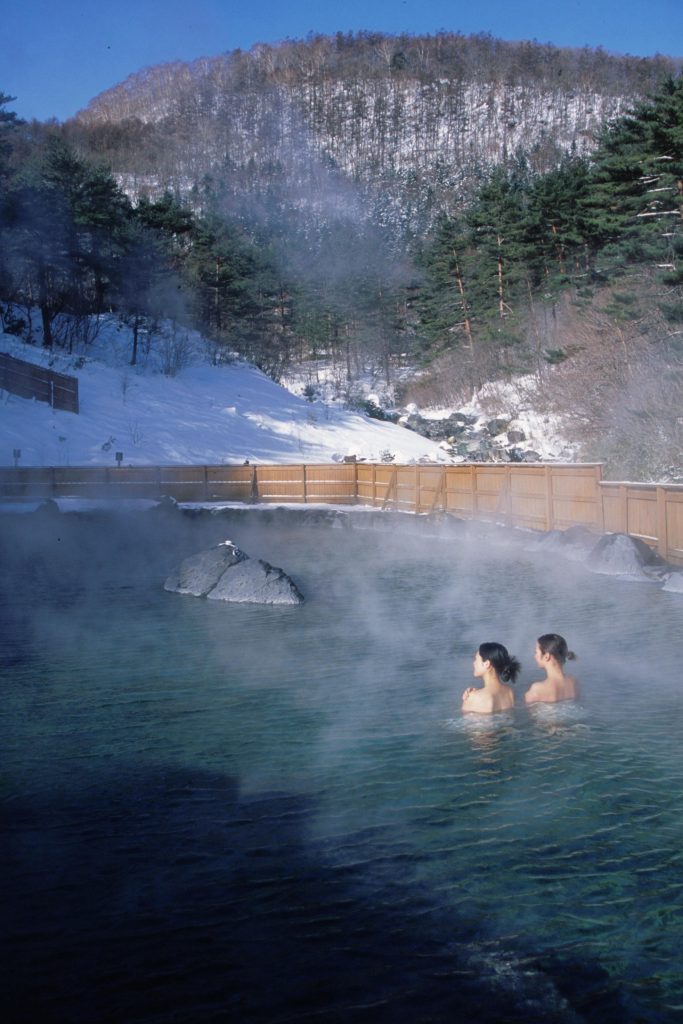
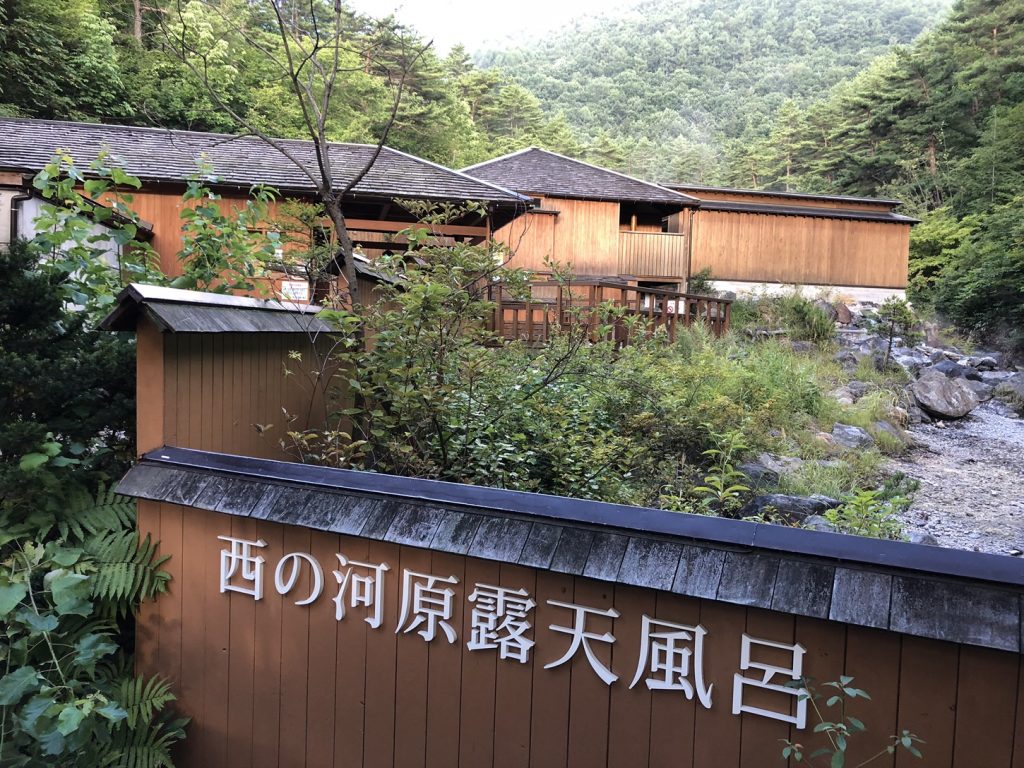
-1024x681.jpg)
Into Enchanted Waters Beloved Since Antiquity
Torrents of milky blue waters descend from the volcanic peaks of Mount Shirane and burst into Kusatsu Onsen’s Yubatake onsen fields, creating clouds of steam that cover the town in a misty haze. This boiling water is then tamed by a centuries-old system of stirring the waters using paddles, in a ceremony called yumomi; cooling it just enough for visitors to take a dip and enjoy the therapeutic benefits of the hot springs.
Considered to be one of Japan’s three most important onsen resorts, Kusatsu boasts so many bathing facilities you’ll be spoiled for choice.
For an especially indulgent experience as you bask in nature, explore Sainokawara Rotenburo, a 500-square meter open-air bath surrounded by forest views. Each season offers a different view—snow-capped trees in winter, cherry blossoms in spring, deep green in summer, and vibrant reds, yellows, and orange in autumn.
For a taste of what Kusatsu was like in centuries past, head to Gozanoyu, a beautifully reconstructed bath facility that combines both Edo- and Meiji-period styles. This expansive facility boasts elegant Japanese architecture and views of the softly steaming Yubatake onsen fields in the town below.
Otakinoyu gives bathers a chance to experience the traditional awase-yu bathing culture, where several baths are taken in turn, each hotter than the last. In the recently renovated bath, the wooden pillars reach up to the ceiling, resembling tall trees standing in the mist as the hot spring steam wraps around them, giving the feeling of being outdoors.
The hot spring’s curative effects are also the stuff of legend. It is said that the waters at Kusatsu Onsen are able to cure any illness but lovesickness. The town’s hot springs are also unrivaled in quantity, boasting the largest output of natural hot spring waters in Japan. With over 32,000 liters gushing out per minute, the waters do not need to be diluted or reheated. High in acidity, bacteria and fungi cannot survive in these piping hot waters, giving it an antibacterial effect that has furthered the belief in the hot springs’ therapeutic effects over the centuries
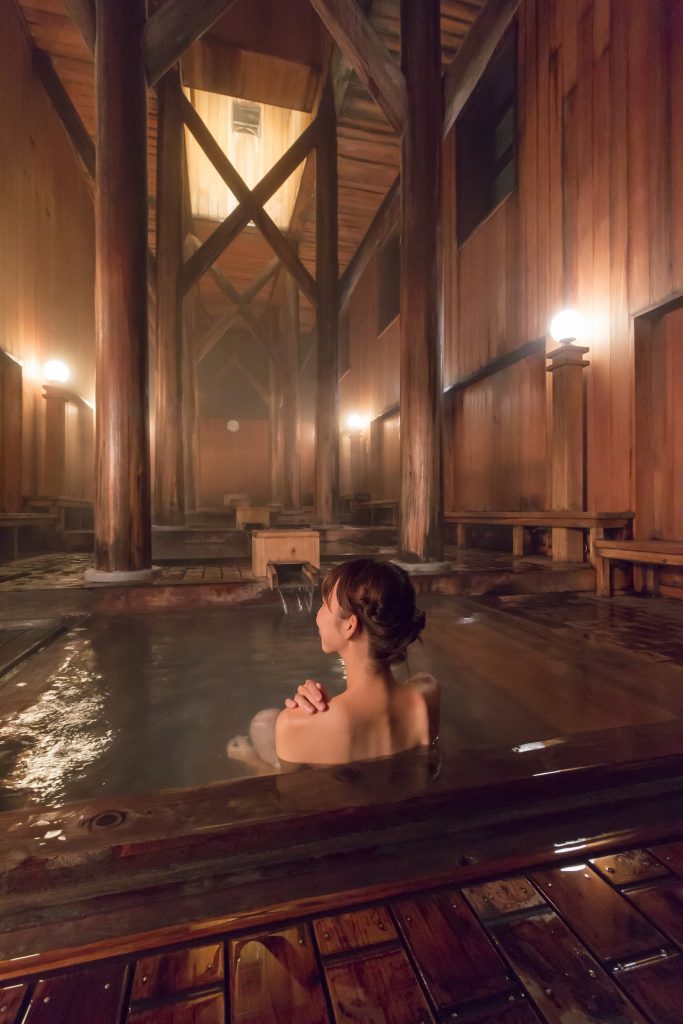

Immerse Yourself in Centuries-Old Bathing Tradition
As one of Japan’s three most famous hot spring resorts, Kusatsu boasts a vibrant traditional onsen town atmosphere so you can experience centuries of Japanese tradition and culture intertwined with the hot springs.
Between baths, stroll down the town’s main street basking in the retro romance as you browse shops laden with local souvenirs, glassware crafts, and more. Drop by one of the many charming confectionary shops to sample tasty wagashi sweets that have been steamed in the therapeutic waters. Enjoy these warm, sweet buns as you stroll the narrow streets around the town, taking in the historic buildings swathed by swirling steam, a sight all the more remarkable when illuminated at night.
To make your visit even more authentic, rent a yukata at Gozanoyu and don it for your outing. A dressing service is available and you do not need to prepare anything yourself! Circle Yubatake and be enveloped in steam as you take in the view of milky blue waters gushing forth through the old pinewood tubs. Free footbaths let you to rest your feet while you enjoy the scenery.

Enjoying Your Visit !
To discover more of the wonders that await you at Kusatsu Onsen, be sure to explore the rest of this website. Here, you’ll find countless tips on where to eat, drink, and stay to find the perfect spots for your visit to Japan’s original resort town. There are also sightseeing suggestions for areas around the town to make the most of your stay here, and examples of popular souvenirs for that special someone at home. If you want to know more about Japanese bathing customs, there is a step-by-step guide available on the website, as well as plenty of information upon arrival to guarantee you turn into an onsen pro.
To make sure you enjoy the baths safely, although the baths have therapeutic effects, it is important to note that your body will sweat more while enjoying them, perhaps more than you may realize. Drink plenty of water between baths to stay hydrated—which you can do with Kusatsu’s own natural mineral waters for an extra dose of well-being. Also, the acidity of some of the waters at Kusatsu Onsen is strong enough to cause silver to develop an instant patina, so be sure to remove all your jewelry before you bathe.
Finally, for guests from overseas, rest assured that the vast majority of Kusatsu Onsen inns and bath facilities are welcoming to those with non-gang-related body art. Travelers with tattoos can enjoy the healing hot waters here without any worries, and join the approximately three million annual visitors to this world-class hot spring resort.
We welcome you to Kusatsu Onsen, and we are sure you will be back time and time again!
Kusatsu Tourism Corporation Kusatsu Onsen Ski Resort
28 Kusatsu-machi, Agatsuma-gun, Gunma 377-1711
Tel: (+81)-279-88-8111
https://www.932-onsen.com
